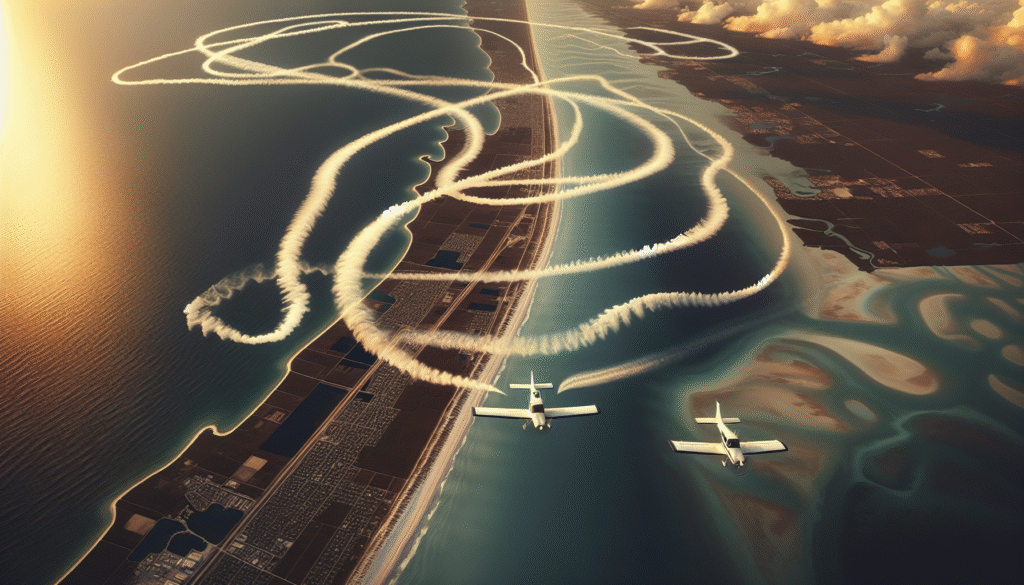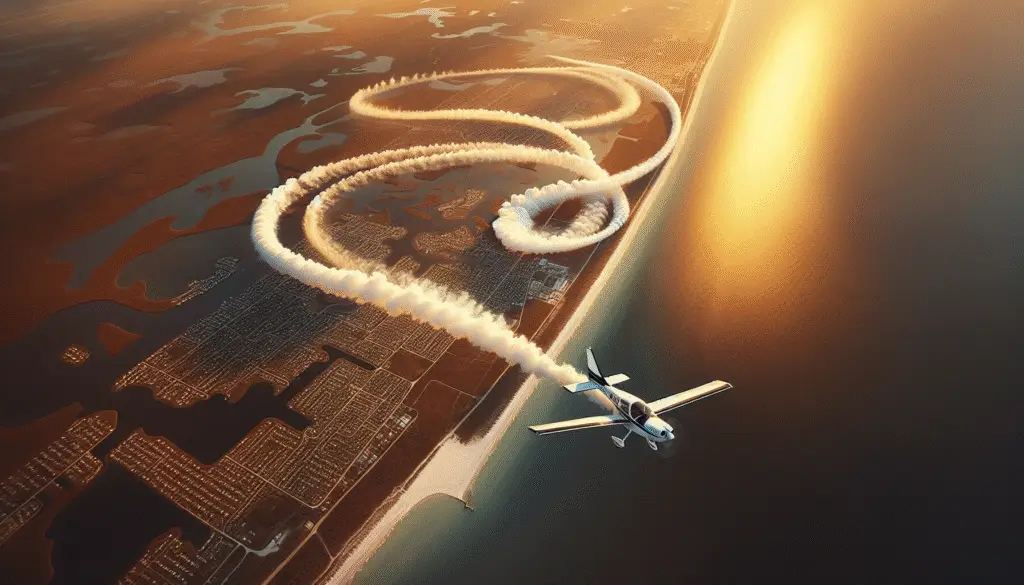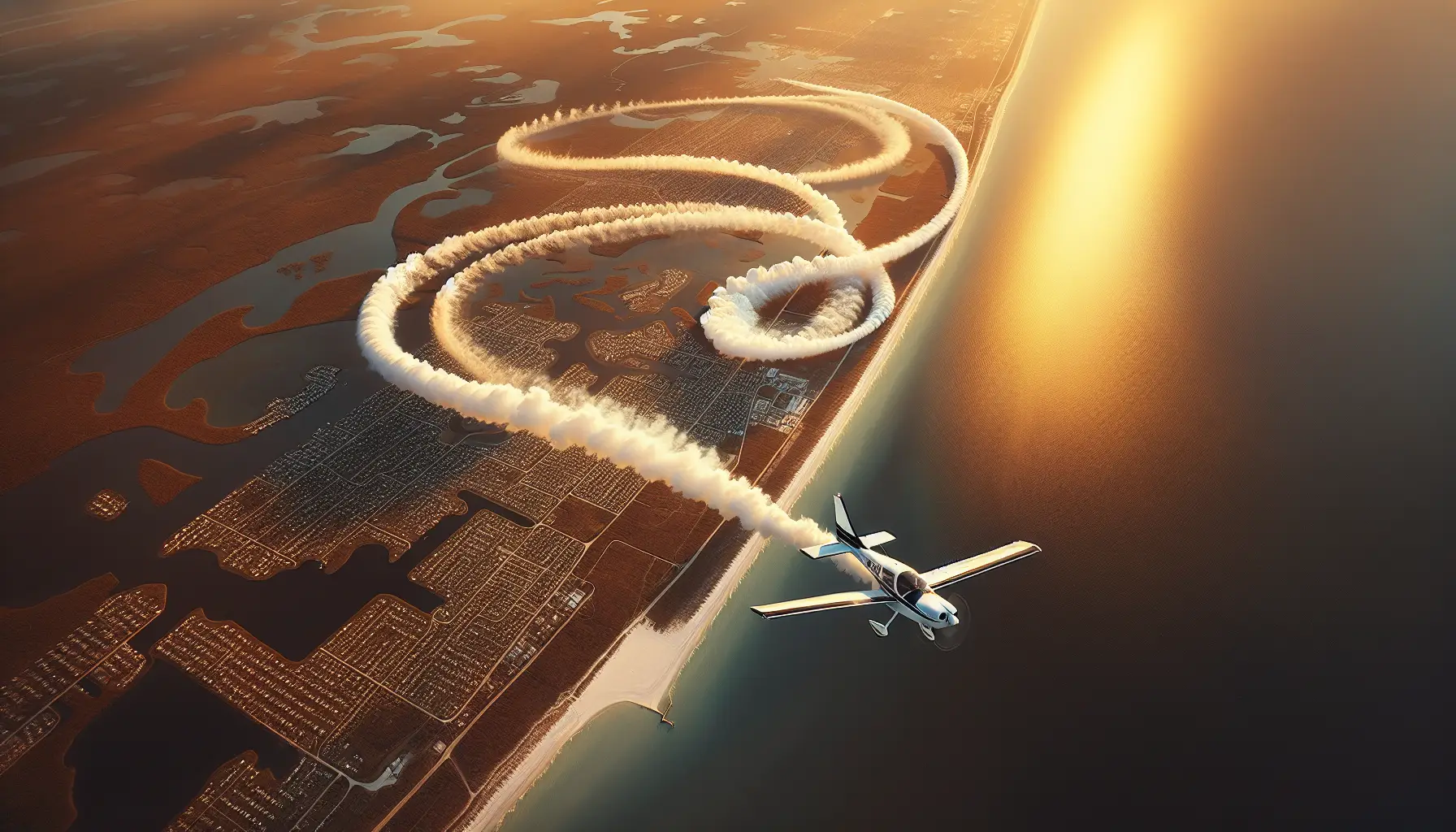Did you ever wonder how a simple flight path could turn into one of the most talked-about moments on social media — and land someone in handcuffs?

What happened: overview of the incident
You probably heard a headline about a Florida man who was arrested after using his private plane to draw a giant penis on radar. In broad strokes, the pilot intentionally flew a route that, when displayed on radar systems and public flight-tracking services, produced a crude image. The pattern showed up on air traffic control displays and on websites and apps that track aircraft, which is what generated public attention and ultimately led to an arrest.
This section lays out the basic facts without legal conclusions. You’ll get more technical and legal details below so you can understand why a prank like this became a law-enforcement matter.
Why the route was visible to others
When you look at a flight-tracking app or an ATC radar screen, you’re seeing data that tells where an aircraft has been and where it’s going. If a pilot deliberately flies a sequence of turns and straight legs to form a picture, that image will appear in any system that plots the aircraft’s path. The aircraft doesn’t literally “draw” on radar — the path it records is what forms the shape.
You’ll see later how different tracking technologies (ADS-B, SSR, MLAT) capture and display that information, and how they’re integrated into public-facing apps.
Why people reacted the way they did
You might find the stunt amusing, childish, or alarming. The image generated fast social sharing because it combined an element of surprise with a big, visible scale. For many viewers it was funny; for others, including authorities, it raised questions about judgment, safety, and legality.
Next you’ll read a clear explanation of the technology involved and why this is more than a harmless prank from an aviation-safety perspective.
How aircraft tracking and radar systems work
You should understand the basic tracking systems to see how a flight path could be rendered as an image for millions to see.
Primary radar vs. secondary radar (SSR)
Primary radar sends a radio pulse and listens for reflections from the aircraft’s body. It doesn’t require any equipment on the plane besides a reflective surface (the airframe itself). Secondary surveillance radar (SSR), by contrast, interrogates transponders on aircraft; the transponder replies with identity and altitude information.
You should note that SSR is how air traffic controllers get altitude and squawk code info — it’s also what passes identity data to many tracking systems.
ADS-B and public flight trackers
ADS-B (Automatic Dependent Surveillance–Broadcast) continuously transmits an aircraft’s GPS-derived position, altitude, speed, and identification. Many modern private aircraft carry ADS-B Out, and public trackers aggregate those signals to present real-time flight paths.
If you’re using a public flight-tracking website or app, you’re almost certainly seeing a combination of ADS-B and radar-fed info. ADS-B makes it particularly easy for a flight path to be shared on public platforms in near real time.
MLAT and other position determination methods
If a plane lacks ADS-B, systems can use multilateration (MLAT) — measuring the time differences between signals received at multiple ground stations — to estimate position. Whether ADS-B, SSR, or MLAT, any of these systems can show the path that a pilot flew, which is why the image of a flight path can be reconstructed and widely viewed.
A table summarizing the technologies:
| System | How it gets position | Typical data available | Role in public tracking |
|---|---|---|---|
| Primary radar | Reflected radio pulses | Relative bearing and range | Mostly ATC, limited to radar coverage |
| SSR (transponder) | Interrogation/reply | Squawk, altitude, sometimes ID | ATC backbone, data feeds to trackers |
| ADS-B | GPS-derived broadcast | Position, altitude, speed, ID | Widely used by public trackers, real-time |
| MLAT | Time-difference of arrival across receivers | Estimated position | Fills gaps for non-ADS-B aircraft |
How a pilot would create a shape on radar
If you want to understand how this happens, imagine you’re drawing with a pencil in the sky. Instead of paper, the canvas is the map on a radar or tracking app; instead of a pencil, you have an aircraft that follows a planned route.
Flight planning and execution
You might plan a series of legs — straight lines and turns — that, when stitched together, form an image. Modern GPS navigation and autopilot systems make it feasible to fly precise courses that result in recognizable shapes.
Even if you’re flying manually, repeated turns and headings flown accurately at a consistent speed will create predictable tracks. You’ll also need to consider wind drift, airspace restrictions, and fuel planning.
Tools and constraints
You’ll probably use navigation tools like GPS waypoints or flight management systems to hold headings and distances. But you must also respect controlled airspace, altitude rules, and traffic; these constraints can limit how large or precise a picture can be.
You should remember that the larger the image you want to create, the more airspace and fuel it will require. That scales both the visibility of the image and the operational complexity.
Legal and regulatory considerations
You might think of this as a harmless prank, but aviation operates under strict safety-focused rules. Authorities don’t just police the sky for arbitrary reasons — they work to protect lives and property.
FAA regulations that might apply
The FAA enforces Federal Aviation Regulations (FARs) that govern safe aircraft operation. Several of these could be relevant if a pilot intentionally creates provocative flight patterns:
- 14 CFR 91.13 — Careless or reckless operation: prohibits operating an aircraft in a careless or reckless manner that could endanger life or property.
- 14 CFR 91.119 — Minimum safe altitudes: sets safe altitude standards except when necessary for takeoff, landing, or certain operations.
- 14 CFR parts related to flight plans, airspace and ATC compliance — failing to comply with ATC instructions or entering restricted airspace can produce enforcement actions.
You should know that FAA enforcement can range from warning letters to certificate suspension or revocation, and civil monetary penalties.
Criminal statutes and local charges
Beyond FAA enforcement, state or federal criminal statutes could be invoked depending on the facts. Possible legal theories include:
- Disorderly conduct or public nuisance (state/local statutes) if the conduct is found to be obscene in public view and causes disturbance.
- Interfering with an aircraft or air navigation systems — though that usually applies when someone tampers with equipment.
- If the stunt involved false statements to ATC or falsified flight plans, there could be fraud or false reporting charges.
You should recognize that criminal charges require specific elements, and prosecutors evaluate whether conduct satisfies them.
Potential outcomes and penalties
Consequences can fall into several categories: administrative (FAA), civil (fines), and criminal (misdemeanor or felony charges). The FAA can take certificates away, which effectively ends a pilot’s ability to fly legally. Local prosecutors can seek fines or jail time under state laws if they believe criminal acts occurred.
A table summarizing possible enforcement and consequences:
| Enforcement actor | Possible action | Typical consequences |
|---|---|---|
| FAA | Administrative enforcement (investigation, warning, certificate action) | Certificate suspension or revocation; civil fines |
| State/local law enforcement | Arrest and prosecution | Misdemeanor or felony charges depending on statute; fines, probation, jail |
| Civil litigants | Civil suits (rare) | Monetary damages if private harm proven |
| Insurance carriers | Coverage review | Denial or increased premiums if excluded behavior found |
Safety and operational concerns
You should think about more than just legality. Stunts like this can present real safety risks for pilots, other aircraft, and the general public.
Distraction and workload
Performing precision flight maneuvers to create a shape increases pilot workload. While attempting repeated turns or holding specific ground tracks, you might become distracted and less able to monitor traffic, communications, or systems.
You must manage workload and maintain a sterile cockpit mindset; reckless or showy flying increases collision risk.
ATC and traffic conflicts
If the stunt occurs in or near controlled airspace, it could conflict with ATC instructions or other traffic. Even if the aircraft remains clear of other planes, its presence may demand increased ATC resources to monitor and separate traffic — resources that you would be diverting from routine safety duties.
Fuel, weather, and equipment considerations
You also risk unexpected weather, fuel shortages, or mechanical issues while engaged in nonstandard flying. You’re committing to additional time airborne and potentially stretching your aircraft’s capabilities or your own planning limits.
How law enforcement identifies the pilot and aircraft
You’re probably wondering how authorities connected the image to one individual and their plane. Air traffic systems and registration records make the identification process straightforward.
Transponder codes and callsigns
ATC assigns discrete transponder codes (squawk codes) that, when combined with radar and transponder replies, let controllers correlate a target with a call sign. Flight plans, ADS-B messages (which include tail number and registration), and ATC voice communications provide identity confirmation.
Tail number and registration lookups
An aircraft’s tail number (N-number in the U.S.) is registered with the FAA and linked to owner information. Any time controllers or investigators collect position data linked to an N-number, they can use registry records to find the owner and operator.
Public footprint via flight trackers
Public flight-tracking apps and social posts create an additional trail. If the flight path was available on popular flight trackers, it’s visible to many third parties who can screenshot, archive, and replay the tracks. This public visibility makes it easier for media and authorities to identify the aircraft quickly.

Possible defenses and legal strategies
If you were in the pilot’s position and facing charges, several defenses might be raised — depending on the facts. You should understand that only a qualified attorney can advise on specific defense strategies.
Lack of intent
Many legal outcomes hinge on intent. You could argue that the pilot lacked an intent to offend, disrupt, or endanger and that the path was an inadvertent artifact of navigation or a misinterpreted flight plan.
No actual endangerment
Another defense is that the pilot’s actions did not endanger life or property and complied with applicable airspace and safety regulations. If no ATC instructions were violated and no traffic or safety incidents occurred, that can mitigate the severity of administrative or criminal charges.
First Amendment concerns (limited)
Some might claim an expressive conduct defense under the First Amendment (if the act is framed as speech). However, courts balance expressive conduct against public safety and regulatory interests. Speech that creates safety risks or violates neutral safety laws often receives lesser protection.
You should treat these as general legal concepts, not legal advice. An aviation attorney will focus on the details: flight logs, ATC recordings, radar data, witness statements, and applicable statutes or regulations.
Public reaction and social media dynamics
You may have seen instant reactions on social media. You’ll find that the internet amplifies the spectacle quickly, and that has several downstream effects.
Virality and memes
When a flight path results in a crude or humorous shape, the image is highly shareable. Screenshots, loops, and jokes can rapidly spread, turning a local event into national or international news within hours.
This virality increases pressure on authorities to respond quickly and can shape public perception even before investigators complete their work.
Media framing and consequences
Media outlets often run sensational headlines because they attract attention. You must remember that headlines can simplify or omit technical and legal complexities. The resulting public pressure can influence investigative resources and political responses.
Impact on the pilot’s life
If you were the pilot, you should expect that the publicity can have major personal consequences: employment ramifications, damage to reputation, and long-term effects on any aviation career. Even if legal penalties are modest, reputation losses can be severe.
Similar incidents and precedents
You might want context about whether this is an isolated incident. There have been other cases where pilots used their aircraft routes for messages or shapes, and authorities have sometimes acted.
Past examples of air-route messages
There have been documented instances of pilots doing flight-path messages for promotions, personal messages, or just for amusement. Authorities typically respond more strongly if the flight intersects with controlled airspace, causes safety concerns, or generates complaints.
You should note that the increasing availability of ADS-B and public tracking apps makes the risk of detection much higher now than in the past.
How authorities have historically responded
Responses have varied: from informal admonitions to the FAA issuing enforcement actions or local law enforcement making arrests. The key factors that determine the severity of response are safety risk, regulatory violations, and the presence of aggravating elements (e.g., harassment, obstruction, or intoxication).
What this means for pilots and aircraft owners
If you fly, you should think carefully about your responsibilities. The novelty of creating a visible image must be weighed against safety, regulations, and professional conduct.
Best practices to avoid trouble
- Always prioritize safety: separation, situational awareness, and ATC compliance come first.
- File accurate flight plans and follow ATC clearances.
- Avoid intentional stunts that could interfere with other aircraft, attract regulatory scrutiny, or be seen as obscene or harassing.
- Understand your aircraft’s certification, equipment, and limitations.
Keeping these practices in mind reduces the risk that a fun idea becomes a career-ending mistake.
If you’re tempted to create messages or shapes
You should step back and ask whether the action could be misinterpreted, risk safety, or violate law. Consider alternative low-risk ways to express yourself that don’t involve public airspace and potential criminal exposure.
What happens after an arrest
If a pilot is arrested, several processes run concurrently: criminal proceedings, FAA investigation, and possibly civil or insurance consequences.
Criminal process
Local authorities will decide whether to charge the pilot based on evidence and applicable statutes. If charged, the pilot could face arraignment, potential plea bargaining, and trial. You should understand that criminal cases can take months to resolve.
FAA enforcement process
Separately, the FAA will likely open an investigation. You may receive a Letter of Investigation (LOI), and the FAA may propose civil penalties or certificate action. You should know that FAA enforcement is administrative and independent; even if criminal charges are dropped, you can still face FAA consequences.
Insurance and civil outcomes
Insurance companies will evaluate whether the flight involves excluded conduct and whether claims arise from negligence or intentional acts. Civil suits are less common unless the route caused property damage or personal harm.
What to do if you witness a suspicious flight
If you see a flight path that looks intentional and offensive or unsafe, you can take steps that are responsible and helpful.
Safety first: stay out of the aircraft’s way
Do not attempt to interfere with the aircraft or its pilot. Your concern should be safety: avoid creating additional hazards.
Report relevant information to authorities
If you believe the flight is endangering people or property, contact local law enforcement or the FAA’s complaint hotline with factual details: time, location, aircraft description, and screenshots if available. If the situation involves immediate danger, call emergency services.
Document but don’t harass
Taking screenshots or recording the track is helpful for investigators, but avoid spreading unverified accusations online. Responsible documentation can assist authorities without inflaming the situation.
Frequently asked questions (FAQs)
You might have specific questions. Here are clear answers to common ones.
Could a pilot lose their license permanently?
Yes. The FAA can suspend or revoke certificates for serious regulatory violations. The severity depends on the conduct, prior record, and findings of the FAA’s investigation.
Is drawing on radar illegal by itself?
There’s no simple statute that says “don’t draw on radar,” but the conduct can violate safety regulations (careless or reckless operation), local laws (nuisance or obscenity statutes), or attract criminal charges if other elements are present. Legal outcomes depend on the facts.
Would ADS-B or transponder tampering be involved?
In most of these incidents, the pilot simply flew a route and used standard transponders/ADS-B. Tampering with equipment would be a distinct and more serious offense.
Can you be arrested just for making people laugh?
Arrest can occur if conduct crossses the line into violating criminal statutes or safety regulations. Public amusement doesn’t shield you from enforcement when the act poses risk or violates the law.
Ethical and social considerations
You should consider the broader ethical implications of turning public infrastructure into a billboard or a joke. Public airspace serves safety-critical functions; using it for personal expression raises questions about the limits of individual freedom when others’ safety or public decency are involved.
Responsibility to the flying community
Pilots are stewards of a shared environment. When you use your aircraft in ways that invite regulatory scrutiny or public criticism, you affect not just yourself but the perception of all general aviation pilots.
Personal consequences beyond the law
Even if legal penalties are modest, social and professional consequences can be long-lasting. Potential employers, insurers, and passengers take trust and judgment seriously.
Conclusion: what you should take away
You should view this incident as a cautionary tale about the intersection of technology, public visibility, and personal responsibility. The ability to broadcast a flight path widely through ADS-B and public trackers means that any intentional spectacle in the sky is likely to be seen, recorded, and judged.
Think about the risks — safety, legal, reputational — before attempting stunts. If you’re a pilot, choose flights that reflect good judgment and respect for the rules and the community. If you’re a member of the public who witnessed or encountered such a flight, document with care and report responsibly if safety is at stake.
If you want to take action or have been involved in such an incident, consult a qualified aviation attorney to understand your rights, obligations, and the best path forward.
